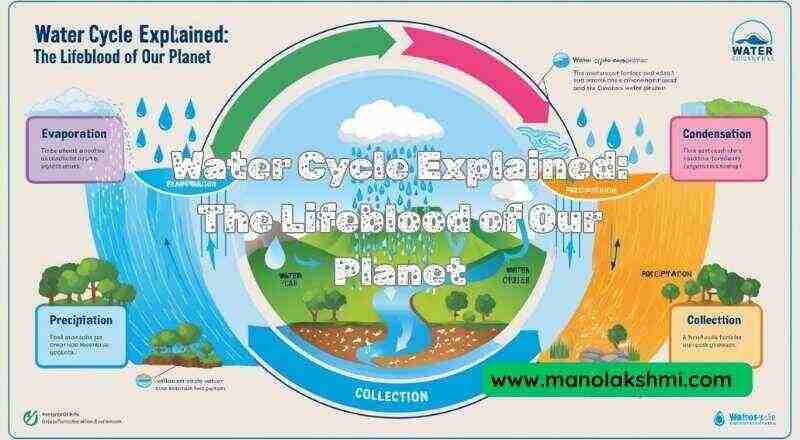The hydrologic cycle, or water cycle, describes the ongoing movement of water across the Earth’s surface, encompassing aboveground, underground, and atmospheric water. This process involves water in its different states: liquid, solid, and gas. This is a continuous process. It is a fundamental process that describes the storage and movement of water between the atmosphere, land, oceans, and freshwater bodies. This cyclical process involves several key stages, including evaporation, transpiration, condensation, precipitation, and collection, each playing a vital role in distributing and purifying Earth’s water supply. The total amount of water on Earth remains relatively constant, but its distribution and form (liquid, solid, gas) are constantly changing due to the driving forces of solar energy and gravity. Comprehending the water cycle’s complexities is fundamental to understanding weather patterns, climate dynamics, and the availability of freshwater, which is vital for both life and human activities.
- Importance of the Water Cycle
- Overview of Water Cycle Components
- Components of the Water Cycle
- Infiltration and Runoff
- The Water Cycle in Different Ecosystems
- Human Impact on the Water Cycle
- Importance of Water Conservation
- Strategies for Water Conservation in Daily Life:
- General Awareness and Habits:
- Conclusion
Importance of the Water Cycle
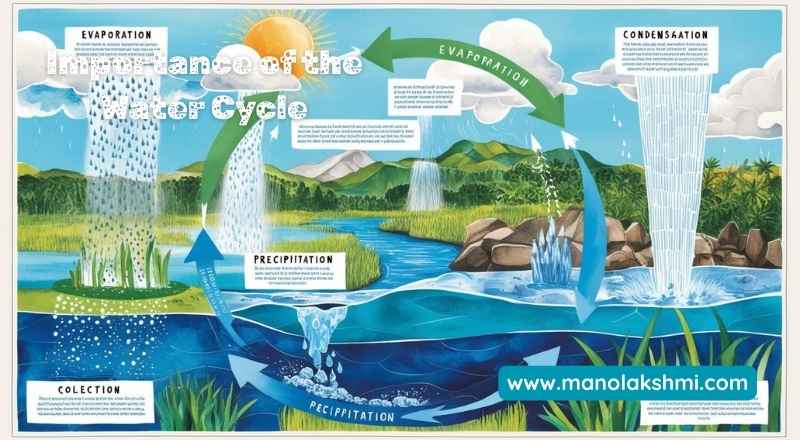
The water cycle refers to the continuous movement of water on, above, and below the Earth. This process is crucial for maintaining ecological balance and supporting all life forms. Its significance can be highlighted through several key aspects:
Supports all life:
Water is the essence of life, and the water cycle ensures its continuous availability in various forms necessary for survival. Plants rely on water for photosynthesis and nutrient transport, animals need it for hydration and bodily functions, and entire ecosystems are structured around the availability of water. The water cycle sustains terrestrial and aquatic habitats, supporting biodiversity and ecological balance. All living things, from the tiniest microbes to the biggest animals, are fundamentally connected to the water cycle.
Regulates climate:
The water cycle is essential in maintaining and regulating Earth’s climate. Through evaporation, water absorbs significant amounts of solar energy, which is then released into the atmosphere during condensation and precipitation. This transfer of energy influences air temperature, humidity, and atmospheric circulation patterns, driving weather systems and moderating global temperatures. Clouds, formed through condensation, reflect incoming solar radiation, contributing to the planet’s energy balance. Additionally, the transport of heat by ocean currents, which are influenced by the water cycle, further contributes to regional and global climate regulation.
Transports nutrients:
The water cycle plays a crucial role in the movement of vital nutrients across various ecosystems. Rain and other forms of precipitation transport dissolved minerals from the atmosphere into terrestrial and aquatic environments. Runoff transports organic matter and minerals from terrestrial ecosystems to rivers and oceans, enriching aquatic environments. Infiltration replenishes groundwater aquifers, which can then release dissolved minerals back into surface waters. This nutrient transport is vital for maintaining soil fertility, supporting plant growth, and sustaining aquatic food webs.
Overview of Water Cycle Components
The water cycle is a dynamic system composed of several interconnected processes that continuously move water through different reservoirs. These key components include:
Evaporation: The process by which liquid water changes into water vapour (a gas) and rises into the atmosphere. Solar radiation serves as the main energy source for evaporation, warming water bodies like oceans, lakes, and rivers, as well as soil. Moreover, wind enhances evaporation by removing water vapour from surfaces.
Transpiration: Plants transport water from their roots to tiny pores located on the lower surface of their leaves. This water then turns into vapour and is released into the air. The journey of water through its cycle includes its release into the surroundings. A significant part of this process is transpiration, which is the evaporation of water specifically from plant leaves, thereby contributing moisture to the air.
Condensation:
Water vapour cools and transforms into liquid water through the process of condensation. This phenomenon generally occurs when humid air rises and encounters lower temperatures in the upper atmosphere. Clouds form when water vapour in the air condenses around microscopic airborne particles known as condensation nuclei.
Precipitation: Rainfall refers to all forms of water that descend from clouds to the surface of Earth. This includes rain, snow, sleet, and hail. Precipitation is the primary way that water returns from the atmosphere to the land and oceans, replenishing surface water and groundwater supplies. The type and amount of precipitation depend on atmospheric conditions such as temperature, pressure, and humidity.
Infiltration: Water from the surface of the ground infiltrates the soil. Infiltration rate is influenced by soil type, saturation, and vegetation. Infiltrated water can replenish soil moisture, recharge groundwater aquifers, and eventually flow into rivers and lakes.
Surface Runoff: The flow of water that occurs when excess stormwater, meltwater, or other sources can no longer sufficiently rapidly infiltrate into the soil. Saturated or impermeable soil leads to surface runoff. This runoff flows over land and ultimately drains into water bodies such as streams, rivers, lakes, and oceans. Surface runoff can transport sediments, nutrients, and pollutants.
Collection: The accumulation of water in various reservoirs such as oceans, lakes, rivers, and groundwater. These water bodies serve as temporary storage for water before it moves through other stages of the water cycle. Oceans are the largest reservoir, holding the vast majority of Earth’s water. Groundwater, stored beneath the Earth’s surface in permeable rock and soil layers called aquifers, is another significant freshwater reservoir. These components are interconnected and operate continuously, driven by solar energy and gravity, ensuring the perpetual circulation of Earth’s water.
Components of the Water Cycle
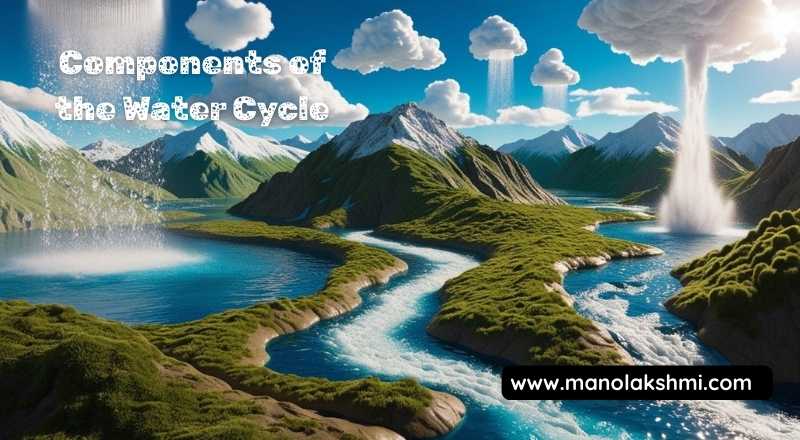
The water cycle, also known as the hydrologic cycle, is a continuous process that describes the movement of water on, above, and below the surface of the Earth. This essential cycle involves several key components that work together to distribute and recycle the planet’s water supply.
Evaporation
- Definition and Process: Water transitioning from its liquid form to a gaseous form, known as water vapour, is called evaporation. When water molecules acquire sufficient kinetic energy to break free from their intermolecular bonds, a phase transition takes place. In liquids, energetic molecules can overcome surface tension and transition into the gaseous phase as water vapour in the atmosphere.
Evaporation is primarily driven by solar radiation, which serves as its main energy source. The sun’s energy heats bodies of water such as oceans, lakes, rivers, and even moisture in the soil, providing the necessary energy for water molecules to vaporise.
Factors Affecting Evaporation:
The rate of evaporation is affected by several environmental factors.
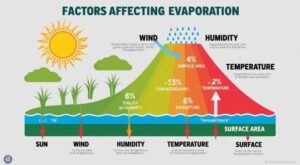
- Temperature: Increased kinetic energy in water molecules, resulting from higher temperatures, accelerates the rate of evaporation. Warmer water contains more molecules with sufficient energy to escape into the gaseous phase.
- Wind Speed: Evaporation from a water surface is increased by wind, which carries away water vapour from the air layer above the water. For increased liquid water evaporation, it is necessary to remove saturated air. This action prevents the air from reaching its water vapor capacity, thus enabling more liquid water to transition into a gaseous state.
- Surface Area: A larger exposed surface area of water allows for more water molecules to be in direct contact with the air, thereby increasing the overall rate of evaporation. Water evaporates more quickly from shallow puddles compared to deep containers, even when both hold the same amount of water.
Evaporation rates depend on humidity and the salinity of the water. Drier air can hold more moisture, leading to higher evaporation rates, while saltier water has stronger intermolecular forces, slightly hindering evaporation.
Transpiration
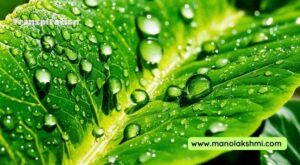
- Definition and Process: Transpiration is the process by which moisture is carried through plants from roots to small pores on the underside of leaves, where it changes to vapour and is released to the atmosphere. Essentially, it is the evaporation of water from plant leaves, stems, and flowers. Water absorbed by the roots is transported upward through the plant’s vascular system (xylem) to the leaves. Specialised cells called stomata, located on the leaf surface, regulate the exchange of gases, including the release of water vapour.
- Role of Plants in the Water Cycle: Transpiration is a significant component of the water cycle, contributing a substantial amount of water vapour to the atmosphere, especially in densely vegetated areas like forests. The rate of transpiration is influenced by various factors, including the type of plant, its stage of growth, and environmental conditions such as sunlight, temperature, wind, and soil moisture availability. Plants play a crucial role in linking the land and atmospheric components of the water cycle.
Condensation
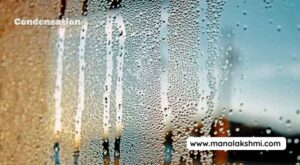
- Definition and Process: Water vapour in the air turns back into liquid water through a process called condensation. This phase change occurs when water vapour cools and loses kinetic energy, causing the water molecules to slow down and come closer together, reforming liquid water droplets. Condensation generally occurs when water vapour in the air comes into contact with a colder surface or when air rises and cools at higher heights.
- Formation of Clouds: Water vapour in the atmosphere often condenses around tiny airborne particles called condensation nuclei, such as dust, pollen, and salt crystals. The condensation of water vapour onto tiny particles, referred to as nuclei, leads to the creation of microscopic water droplets. When a large number of these tiny droplets come together, they become visible as clouds. Different types of clouds form at various altitudes and atmospheric conditions, reflecting different condensation processes and water content.
Precipitation
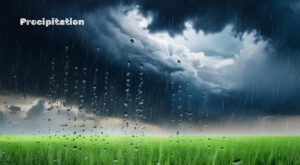
Types (rain, snow, sleet, hail): Precipitation is any form of water that falls from clouds to the Earth’s surface. As water droplets or ice crystals within clouds accumulate significant weight, gravity overcomes the updraft forces supporting them, leading to their descent as precipitation. Precipitation occurs in various forms depending on atmospheric temperature.
- Rain: Liquid water descends to the ground in the form of droplets.
- Snow: Freezing atmospheric temperatures are a prerequisite for snow formation.
- Sleet: Small, translucent balls of ice. When snow falls through a warm air layer and melts into rain, it can refreeze into sleet upon passing through a freezing air layer near the ground.
- Hail: Thunderstorm clouds, specifically cumulonimbus clouds, are where hailstones develop due to strong upward currents of air within them. These strong upward air currents lift water droplets into extremely cold parts of the cloud, causing them to freeze and form lumps of ice. The ice particles may then cycle up and down within the cloud, accumulating layers of ice until they become too heavy for the updrafts to support and fall to the ground.
Importance of Precipitation in Replenishing Water Sources:
Water primarily returns from the atmosphere to the Earth’s surface through precipitation. It is essential for replenishing various water sources, including surface water bodies like rivers, lakes, and reservoirs, as well as groundwater aquifers. Precipitation provides the freshwater necessary to support ecosystems, agriculture, human consumption, and various industrial processes. Precipitation’s amount, timing, and form are crucial factors influencing water availability and environmental health.
Infiltration and Runoff

- Infiltration Definition: Water permeates the soil through a process known as infiltration, which occurs when water on the ground surface enters the ground. The rate of infiltration is influenced by several factors, including the permeability of the soil, the slope of the land, the intensity and duration of precipitation, and the amount of moisture already present in the soil.
Permeable soils with large pore spaces allow water to infiltrate more readily than less permeable soils like clay.
- Runoff Definition and Process: Runoff is the movement of water that happens when the ground cannot absorb excess water from rain, melted snow. (or) other sources quickly enough. Runoff is the movement of water that happens when the ground cannot absorb excess water from rain, snowmelt, or other sources quickly enough.
This can occur when the soil is saturated, when the rate of precipitation exceeds the infiltration capacity of the soil, or on impervious surfaces such as paved roads and buildings. Water that flows across the land’s surface frequently gathers in natural depressions, forming channels, streams, and rivers.
Importance to Rivers, Lakes, and Groundwater:
Both infiltration and runoff play crucial roles in maintaining and replenishing surface water and groundwater resources. Infiltrated water percolates through the soil and rock layers, eventually reaching groundwater aquifers. Which are vital sources of water for drinking, irrigation, and ecosystems. Runoff collects in surface depressions and flows into rivers and lakes, providing water for various uses and sustaining aquatic habitats. The balance between infiltration and runoff is influenced by land cover and land use practices. For example, forests and vegetated areas tend to promote infiltration, while urbanized areas with extensive impervious surfaces lead to increased runoff. Understanding these processes is essential for effective water resource management and mitigating the impacts of floods and droughts.
The Water Cycle in Different Ecosystems
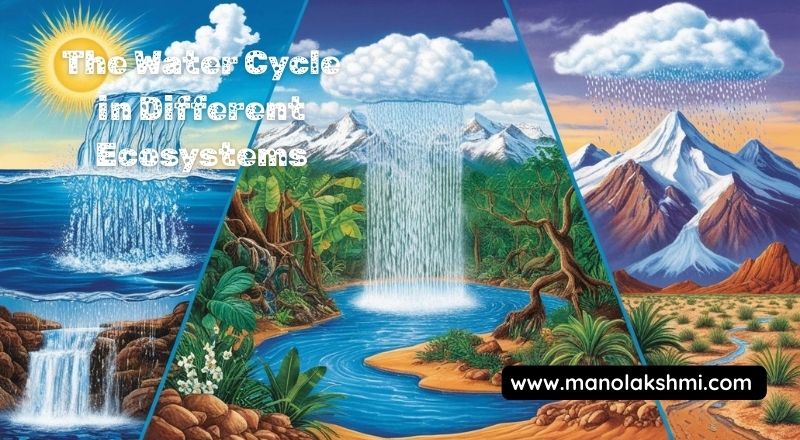
Aquatic Ecosystems (lakes, rivers, oceans)
- Role of the Water Cycle in Aquatic Habitats: The water cycle is fundamental to the existence and health of aquatic ecosystems. Water loss through evaporation from the surfaces of lakes, rivers, and oceans is a major source of moisture in the atmosphere. Precipitation replenishes these water bodies, maintaining water levels necessary for the survival of aquatic organisms.
The continuous movement of water facilitates nutrient cycling, oxygen distribution, and temperature regulation within these habitats. Different aquatic environments have unique characteristics related to the water cycle; for instance, ocean currents play a vital role in global heat distribution, while seasonal changes in river flow impact the life cycles of many freshwater species. The salinity of oceans, influenced by evaporation and precipitation patterns, is a critical factor for marine life.
Terrestrial Ecosystems (forests, grasslands, deserts)

- Impact of Water Availability on Plant and Animal Life: Water availability is a primary limiting factor for life in terrestrial ecosystems. Forests rely on consistent rainfall for the growth of trees and understory vegetation, which in turn provide habitat and food for a diverse array of animals. Grasslands experience seasonal variations in rainfall, influencing the types of grasses that can grow and the grazing animals they support.
Deserts are characterized by extremely low water availability, leading to specialized adaptations in both plants (e.g., water storage, reduced leaf surface area) and animals (e.g., nocturnal activity, efficient water conservation). The distribution and abundance of species within terrestrial ecosystems are directly linked to patterns of precipitation, evapotranspiration, and soil moisture.
Urban Areas
- Human Impact on the Water Cycle: Urbanization significantly alters the natural water cycle. Impervious surfaces, including roads, buildings, and parking lots, inhibit infiltration and result in increased surface runoff. Deforestation and the removal of vegetation further decrease evapotranspiration.
Water extraction for domestic, industrial, and agricultural use can deplete local water sources and impact downstream ecosystems. Wastewater discharge, if not properly treated, can pollute water bodies, disrupting aquatic life and potentially contaminating drinking water supplies. Atmospheric pollution affects both patterns and water quality.
- Stormwater Management: Urban areas face a significant challenge in managing stormwater runoff. Higher surface runoff increases the risk of floods and erosion, while also carrying pollutants into water bodies like rivers and lakes. Traditional stormwater management systems often rely on pipes and channels to quickly divert water away from urban areas.
However, more sustainable approaches, such as green infrastructure (e.g., permeable pavements, rain gardens, green roofs), aim to mimic natural processes by increasing infiltration, reducing runoff volume, and filtering pollutants. Effective stormwater management is essential for protecting both urban infrastructure and the health of surrounding aquatic ecosystems.
click here: Soundscapes of Nature: The Language of the Wild
Human Impact on the Water Cycle

Human activities exert significant pressure on the natural processes of the water cycle, leading to alterations with far-reaching consequences for ecosystems and human societies.
Climate Change
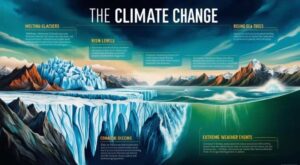
Anthropogenic emissions of greenhouse gases are driving significant changes in the global climate, with profound effects on the water cycle.
- Altered evaporation rates: Rising global temperatures increase the rate of evaporation from bodies of water (oceans, lakes, rivers) and the land surface. This can lead to increased atmospheric water vapor, potentially intensifying precipitation in some areas.
However, it also contributes to increased aridity and drought in other regions where evaporation outpaces precipitation. Changes in snow and ice melt, key components of the water cycle in many regions, further complicate evaporation patterns and water availability.
- Changing precipitation patterns: Climate change disrupts atmospheric circulation patterns, leading to shifts in the timing, intensity, and geographic distribution of precipitation. Some areas experience more frequent and intense rainfall events, increasing the risk of flooding and erosion.
Conversely, other regions face prolonged periods of reduced rainfall, leading to drought conditions, water scarcity, and impacts on agriculture and ecosystems. The predictability of seasonal rainfall patterns, crucial for agriculture and water resource management, is also being affected.
Water Pollution
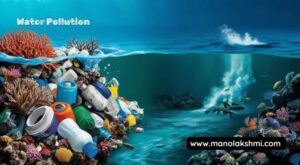
The contamination of water sources by human activities poses a major threat to the quality and availability of freshwater, with cascading effects on the water cycle.
- Sources of pollution: Water pollutants originate from a wide range of sources, including industrial discharge (heavy metals, chemicals), agricultural runoff (fertilizers, pesticides, animal waste), domestic wastewater (sewage, detergents), and urban runoff (oil, litter, chemicals).
Atmospheric deposition of pollutants from industrial emissions and vehicle exhaust also contributes to water contamination. Landfills and mining operations can leach pollutants into groundwater, a vital source of drinking water and baseflow for rivers.
- Effects on the water cycle: Water pollution can disrupt the natural balance within the water. Contaminants can reduce dissolved oxygen levels, harming aquatic life and altering biogeochemical cycles. Pollutants can also decrease infiltration rates by clogging soil pores or forming impermeable layers. The presence of pollutants in evaporated water has the potential to impact the quality of precipitation.
Furthermore, the contamination of surface and groundwater sources reduces the availability of clean water for human use and ecosystems, impacting various stages of the water cycle and its benefits.
Deforestation
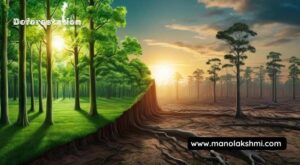
The clearing of forests for agriculture, urbanization, and other purposes has significant impacts on local and regional water cycles.
- Impact on transpiration and rain patterns: Forests play a crucial role in the water cycle through transpiration, the process by which trees release water vapor into the atmosphere. Large-scale deforestation reduces the amount of water vapor transpired, potentially leading to decreased cloud formation and reduced rainfall in the region.
Forests also influence local air currents and temperature, which can affect precipitation patterns. The loss of forest canopy reduces interception of rainfall, leading to increased surface runoff and soil erosion, which can further disrupt water infiltration and groundwater recharge.
Urbanization

The expansion of urban areas alters the natural water cycle through changes in land cover and water management practices.
Increased runoff and decreased infiltration: The replacement of natural vegetation and permeable surfaces with impervious materials like concrete and asphalt in urban areas significantly increases surface runoff during rainfall events. This reduces the amount of water that infiltrates the ground to recharge groundwater aquifers.
The heightened volume and speed of runoff can result in urban flooding, intensified erosion in waterways, and the conveyance of pollutants into surface water bodies. Urban drainage systems are designed to quickly remove stormwater, further limiting infiltration and potentially overwhelming downstream water systems.
Importance of Water Conservation

Reasons for Conservation:
Water conservation is paramount for a multitude of interconnected reasons, impacting environmental, economic, and social well-being.
- Scarcity: While the Earth’s surface is largely covered by water. Only a small fraction is freshwater readily available for human use. Growing global populations and increasing demand for agriculture, industry, and domestic purposes are exacerbating water scarcity in many regions.
Climate change further intensifies this issue through altered precipitation patterns, prolonged droughts, and glacial melt. Conserving water helps ensure a more reliable and sustainable supply for current and future generations.
- Environmental Protection: Water ecosystems, including rivers, lakes, and wetlands, are vital habitats for diverse flora and fauna. Over-extraction and inefficient water use can lead to the degradation and loss of these precious ecosystems.
Reduced water flow can harm aquatic life, while the drying up of wetlands diminishes their role in filtering water and providing crucial habitats. Conservation efforts minimize our impact on these natural environments and help maintain biodiversity.
- Economic Benefits: Water is a critical input for numerous economic activities, including agriculture, manufacturing, energy production, and tourism. Water shortages can lead to significant economic losses, affecting food security, industrial output, and overall development.
Investing in water-efficient technologies and promoting conservation practices can reduce water-related costs for businesses and consumers, enhance productivity, and ensure long-term economic sustainability.
- Energy Savings: Treating and transporting water require significant amounts of energy. By using less water, we can reduce the energy demand associated with water management, leading to lower greenhouse gas emissions and contributing to climate change mitigation efforts.
- Social Equity: Access to clean and safe water is a fundamental human right. Water scarcity and unequal distribution can lead to social unrest, health problems, and hinder poverty reduction efforts. Water conservation can help ensure a more equitable distribution of this vital resource, particularly in water-stressed regions, and improve public health outcomes by ensuring access to sufficient water for sanitation and hygiene.
Strategies for Water Conservation in Daily Life:

To make a significant collective impact on water conservation, it is essential to incorporate water-saving habits into our daily lives. By adopting water-efficient technologies and making simple changes to our routines, we can substantially decrease our water footprint.
In the Bathroom:
- Take shorter showers instead of baths.
- Conserve water by turning off the tap during teeth brushing, shaving, and handwashing.
- Install low-flow showerheads and faucet aerators.
- Repair leaky faucets and toilets promptly. A malfunctioning toilet can result in significant water wastage, potentially amounting to hundreds of gallons each day.
- Avoid flushing the toilet unnecessarily. Please discard used tissues and other waste in the designated waste bin.
In the Kitchen:
- Use a dishwasher efficiently.
- To conserve water while hand-washing dishes, avoid running water continuously. Fill one sink for washing and another for rinsing.
- To conserve water, use a bowl filled with water to rinse fruits and vegetables instead of washing them under a running tap.
- For safe thawing, use the refrigerator or microwave instead of running water.
- Collect and reuse water from rinsing vegetables or boiling pasta for watering plants.
Laundry Practices:
- Wash full loads of laundry instead of small ones.
- Adjust the water level on your washing machine to match the load size, if possible.
- Consider using a water-efficient washing machine.
Outdoor Water Use:
- Water lawns and gardens deeply but less frequently to encourage deep root growth.
- Minimize water loss from evaporation by watering plants in the early morning or late evening when temperatures are cooler.
- Use a watering can or soaker hoses instead of sprinklers to target water directly at plant roots.
- Collect rainwater in barrels for watering plants.
- Choose drought-tolerant plants and landscaping.
- Preserve the cleanliness of driveways and sidewalks by them with a broom rather than using a hose.
- Cover swimming pools to reduce evaporation.
- Wash your car at a commercial car wash that recycles water, or if washing at home, use a bucket and sponge instead of a running hose.
General Awareness and Habits:
Reduce your water usage by identifying areas for improvement in your consumption habits. Educate family members and colleagues about the importance of water conservation. Support water conservation initiatives in your community.
Role of Education and Awareness in Promoting Sustainable Practices:
Education and awareness campaigns are fundamental to fostering a culture of water conservation and promoting the adoption of sustainable practices at all levels of society.
Public Awareness Campaigns: Targeted campaigns can effectively communicate the importance of water conservation, highlight the consequences of water scarcity, and provide practical tips for saving water in daily life. Utilizing various media channels, including television, radio, social media, and print materials, can reach a wide audience.
- Educational Programs in Schools: Integrating water conservation into school curricula from an early age can instill lifelong habits and a sense of responsibility towards water resources. Hands-on activities, experiments, and discussions can help students understand the water cycle, the challenges of water scarcity, and the impact of their water use.
- Community Workshops and Seminars: Organizing workshops and seminars for the general public can provide more in-depth information on water-saving techniques, water-efficient technologies, and local water management issues. These events can also serve as platforms for sharing best practices and fostering community engagement.
Information and Labeling:
Clear and informative labeling of water-efficient appliances, fixtures, and products can empower consumers to make informed choices. Providing information on water usage and conservation tips on water bills can also raise awareness and encourage behavioral changes.
- Role Models and Influencers: Featuring individuals and communities that have successfully implemented water conservation practices can inspire others to adopt similar behaviors. Highlighting the benefits of water conservation through real-life examples can be more impactful than simply providing statistics.
- Engaging Stakeholders: Collaboration between governments, water utilities, businesses, non-governmental organizations, and community groups is essential for developing and implementing effective water conservation strategies. Raising awareness among policymakers and industry leaders can lead to the adoption of water-efficient policies and technologies on a larger scale.
- Utilizing Technology: Interactive tools, mobile applications, and online resources can provide users with personalized feedback on their water consumption, offer water-saving tips, and connect them with relevant information and resources. Smart water meters can also help consumers track their usage and identify potential leaks.
By investing in education and awareness initiatives, we can empower individuals and communities to become active participants in water conservation efforts, ensuring a sustainable and secure water future for all.
Conclusion
This document has explored the intricate and vital processes of the water cycle, underscoring its significance for all life on Earth. We have detailed the various stages, including evaporation, transpiration, condensation, precipitation, and collection, illustrating how water continuously circulates through the environment. The interconnectedness of these stages and the delicate balance within the cycle have been emphasized. Furthermore, we have examined the diverse array of water resources available, from surface water like rivers and lakes to groundwater aquifers, and their crucial roles in supporting ecosystems, human societies, and economic activities. The pressures and challenges facing these resources, such as pollution, over-extraction, and the impacts of climate change, have also been discussed, highlighting the urgent need for responsible management.
The Necessity of Sustainable Practices:
The continued health and functionality of the water cycle and the availability of clean and sufficient water resources are not guaranteed. Unsustainable practices, driven by population growth, industrial expansion, and unsustainable consumption patterns, are placing unprecedented strain on these natural systems. Pollution from agricultural runoff, industrial discharge, and urban waste degrades water quality, rendering it unusable for many purposes and harming aquatic life. Over-extraction of groundwater depletes aquifers, leading to land subsidence, reduced streamflow, and ecological damage. Climate change exacerbates these issues, altering precipitation patterns, increasing the frequency and intensity of droughts and floods, and impacting snowpack and glacier melt, which are vital sources of freshwater for many regions. Therefore, the adoption of sustainable practices across all sectors is not merely an option but a fundamental necessity for ensuring the long-term health of our planet and the well-being of future generations.
Call to Action for Protecting the Water Cycle and Water Resources:
Protecting the water cycle and ensuring the sustainable management of our water resources requires a concerted and collaborative effort involving individuals, communities, governments, and the private sector. We must embrace water conservation measures in our daily lives, reducing our water footprint through mindful consumption and efficient use.
Industries need to adopt cleaner production technologies and implement robust wastewater treatment systems to minimize pollution. Agriculture must transition towards water-efficient irrigation techniques and reduce the use of harmful chemicals.
Governments have a crucial role in enacting and enforcing strong environmental regulations, investing in water infrastructure, promoting integrated water resource management, and fostering international cooperation on transboundary water issues. Education and public awareness campaigns are essential to instill a sense of responsibility and encourage active participation in water stewardship.
By working together, embracing innovation, and prioritizing the long-term health of our planet, we can safeguard the water cycle and ensure a secure and sustainable water future for all.
Measurement: Understanding Rain Gauges and Their Importance
